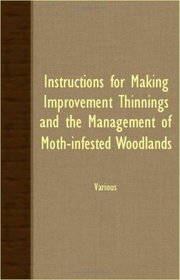Search -
Instructions For Making Improvement Thinnings And The Management Of Moth-Infested Woodlands
Instructions For Making Improvement Thinnings And The Management Of Moth-Infested Woodlands
Author:
INSTRUCTIONS FOR MAKING IMPROVEMENT THINNINGS AND THE MANAGEMENT OF MOTH - I N F E S T E D WOODLANDS - HOW TO MAKE IMPROVEMENT THINNINGS IN MASSACHUSETTS WOODLANDS. - IMPORTANCE OF THINNING. - By improvement thinnings and cuttings we mean the systematic removal of a portion of the trees in a growing forest, in order to benefit the portioi that r... more »
Author:
INSTRUCTIONS FOR MAKING IMPROVEMENT THINNINGS AND THE MANAGEMENT OF MOTH - I N F E S T E D WOODLANDS - HOW TO MAKE IMPROVEMENT THINNINGS IN MASSACHUSETTS WOODLANDS. - IMPORTANCE OF THINNING. - By improvement thinnings and cuttings we mean the systematic removal of a portion of the trees in a growing forest, in order to benefit the portioi that r... more »
ISBN-13: 9781408624555
ISBN-10: 1408624559
Publication Date: 10/29/2007
Pages: 56
Rating: ?
ISBN-10: 1408624559
Publication Date: 10/29/2007
Pages: 56
Rating: ?
0 stars, based on 0 rating




